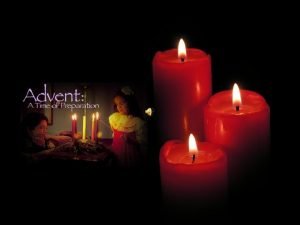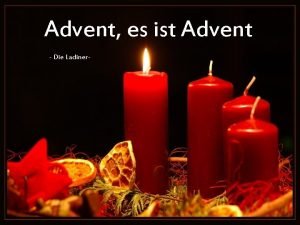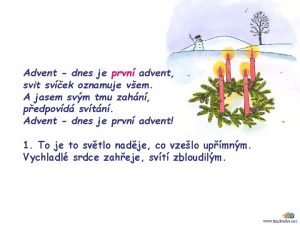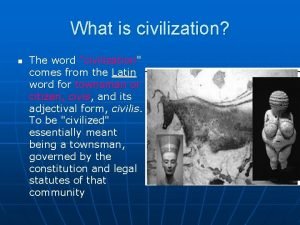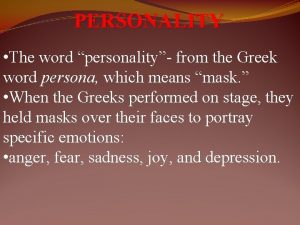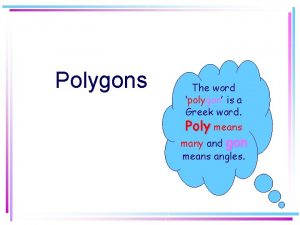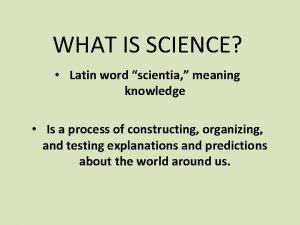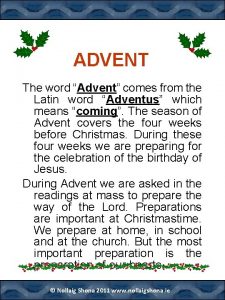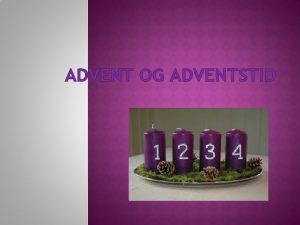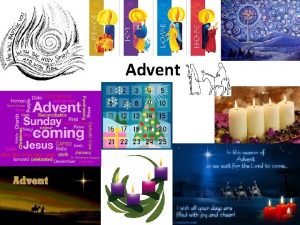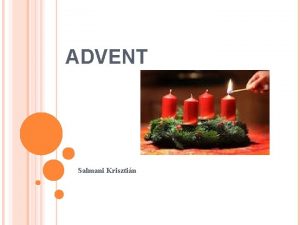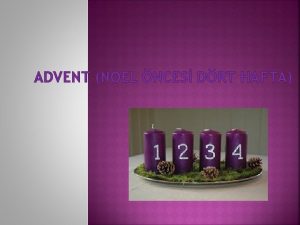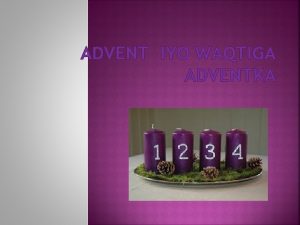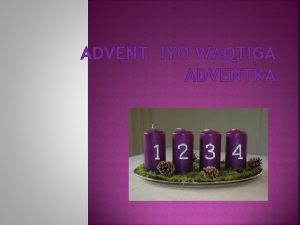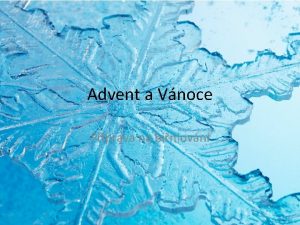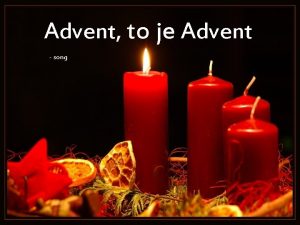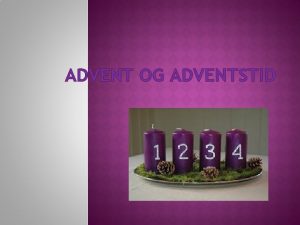Advent The word Advent comes from the Latin
















- Slides: 16


Advent The word Advent comes from the Latin word “adventus” and means "coming" It is associated with the four weeks of preparation before Christmas. Advent always has four Sundays, beginning on the Sunday nearest the feast of St. Andrew the Apostle, (November 30)

How Do We Know When Advent Begins • There are two answers. • The Sunday closest to the feast day of St. Andrew the Apostle or • Find Christmas and count backwards four Sundays. • If Christmas Eve is a Sunday, it is counted as the fourth Sunday of Advent, with Christmas Eve beginning at sundown.

The Word Advent • The word Advent means "coming" or "arrival. " • The focus of the entire season is the celebration of the birth of Jesus on His First Advent, and • The anticipation of the return of Christ the King in His Second Advent.

Advent Scriptures • Scripture readings for Advent will reflect an emphasis on the Second Advent, they including themes of : • accountability for faithfulness at His coming, • judgment on sin, and • the hope of eternal life.

Getting Ready Advent continues until December 24. It blends together both a joyful and penitential spirit, It’s similar to Lent, a liturgical theme of preparation for the Second and Final Coming of the Lord, called the Parousia, and A joyful theme of getting ready for the Bethlehem event.

Advent & Easter • Since the 900 s Advent has been considered the beginning of the Church year. • This does not mean that Advent is the most important time of the year. • Easter has always had this honor. • The traditional color of Advent is purple or violet which symbolizes the penitential spirit. • Purple is also a symbol of royalty. • That color is used because we are waiting for the arrival of a king, Jesus.

Where Did The Advent Wreath Come From? • The origins are uncertain. • There is evidence of pre-Christian Germanic peoples using wreathes with lit candles during the cold and dark December days as a sign of hope in the future warm and extended-sunlight days of Spring.

Who Used It? • By the Middle Ages, the Christians adapted this tradition and used Advent wreaths as part of their spiritual preparation for Christmas. • After all, Christ is “the Light that came into the world” to dispel the darkness of sin and to radiate the truth and love of God (cf. John 3: 19 -21). • By 1600, both Catholics and Lutherans had more formal practices surrounding the Advent wreath.

What’s the Symbolism found in the Wreath? • • • Evergreens, signifying continuous life The laurel (A Mediterranean evergreen tree) signifies victory over persecution and suffering Pine, and holly, are signs of immortality Cedar is a sign of strength and healing Holly’s prickly leaves remind us of the crown of thorns

The Circle • The circle of the wreath, symbolizes no beginning or end, and the eternity of God, • the immortality of the soul, and • the everlasting life found in Christ. • Any pine cones, nuts, or seedpods used to decorate the wreath also symbolize life and the resurrection.

The Four Candles • The four candles represent the four weeks of Advent. • The tradition is that each week represents one thousand years, • The 4, 000 years from Adam and Eve until the birth of the Savior.

Three Purple Candles • The purple candles symbolize the prayer, penance, and goods works undertaken at this time. • The rose candle is lit on the third Sunday • This is a Sunday of rejoicing, because the faithful have arrived at the midpoint of Advent, when their preparation is now half over and they are close to Christmas.

Lighting of the Candles • The progressive lighting of the candles symbolizes the expectation and hope surrounding our Lord’s first coming into the world and • The anticipation of His second coming to judge the living and the dead.

A White Candle? • Some modern day adaptations include a white candle placed in the middle of the wreath. • This candle represents Christ and is lit on Christmas Eve.

Color and Symbolism • First week = Purple is a symbol meaning Hope. • Second week = Purple symbolizes Love. • Third week = The rose color means Joy. • The fourth candle which is Purple means Peace. • The optional white candle symbolizes Jesus’ birth on Christmas Day.
 The word advent comes from the latin word ______________
The word advent comes from the latin word ______________ Revelation in latin
Revelation in latin The word computer
The word computer Advent es ist advent
Advent es ist advent Dnes je první advent
Dnes je první advent Audit has been derived from the latin word
Audit has been derived from the latin word Scenario 1 floor wax answers
Scenario 1 floor wax answers Civilization comes from the latin word
Civilization comes from the latin word Parts of a greek temple
Parts of a greek temple The word tessellation comes from the root word
The word tessellation comes from the root word Brazen sonnet
Brazen sonnet Greek word for physics
Greek word for physics The word personality comes from the greek word __________
The word personality comes from the greek word __________ Polygon greek word
Polygon greek word The columns at the parthenon follow the ________ order.
The columns at the parthenon follow the ________ order. First comes love, then comes marriage
First comes love, then comes marriage Latin word meaning knowledge
Latin word meaning knowledge
